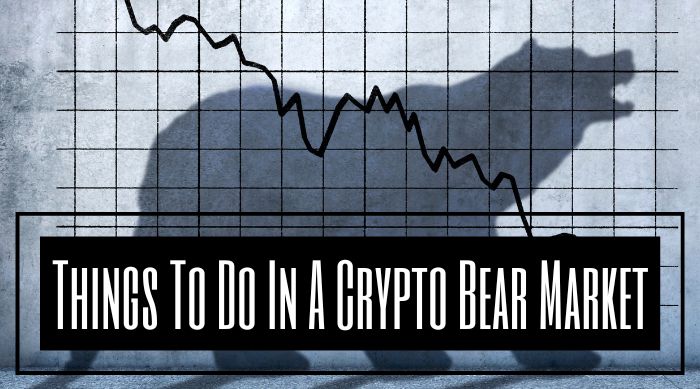What should you do in a crypto bear market? A bear market is one that has lost above 20% of its value in a year.
In 2022, Bitcoin felt the bear market pinch, down as much as 35% with Ethereum down even more. What should cryptocurrency investors do in a bear market? Your options include panicking and selling at a loss, or you could choose to “buy the dip”. There are other choices, but those are the two most obvious ones.

What follows is not investment advice, but information that can give you an idea of what to expect should you choose to take one of the steps listed below. Consider these to be choices–we do not endorse these choices, but rather present them for you to consider as a place to begin research into these approaches.
Things To Do In A Crypto Bear Market: Panic
During the Great Recession (2007 to 2009) some professionals began to worry about their 401k retirement accounts and home values. Both took a serious hit during this time, with home values alone falling some 30%. Those who cashed in their 401ks might have felt justified at the time, but did that panic and the resulting choices made bring any lasting results?
It’s not that these people did something wrong by cashing in a 401k they were worried about, but rather the emotional state that some let drive their investment choices. If you choose to cash in during a bear market, it’s best to make that choice with a cool head and plenty of thinking time.
There is no crime in dumping an investment that has gone south, but if you divest without a strategy and a longer-term plan, you might be cheating yourself. We’ve written about this plenty of times here, but it’s worth repeating. Emotional investing is a terrible idea. Even if you sell, don’t sell with a head full of panic.
Things To Do In A Crypto Bear Market: Sell And Come Back
Some choose to sell off their holdings in a bear market but don’t do so in a state of panic. Instead, these investors may choose to cut their losses early and divest, only to come back later to see if conditions have worsened or improved.
Why sell at a loss and buy back in later? In some cases, it may be due to observations in the investment’s long-tail data. The sell-off may be in response to part of a cycle that wasn’t previously observed, or it may be due to stop-loss orders placed to avoid losing more investment money.
Why does an investor come back to a floundering opportunity later? In general, it may be due to ignorance, but also just as likely due to the investor knowing the opportunity well enough to feel safe betting on its future success. For example, if you bought Starbucks stock in 2004 and sold it as 2007 and the recession approached, you likely sold it at a loss. But if you bought in after that recession ended hoping to bet on the rise of the stock again? And paid $69 per share in 2019?
Your potential profit would be much higher after Starbucks stock hit an all-time high of just above $126 in July of 2021. But those who know this stock well have watched it rise and fall within certain benchmarks over many years. The gamble on this particular investment wasn’t as risky as if you had done the same thing with a cryptocurrency with only a year or so on the books, performance-wise.
Things To Do In A Crypto Bear Market: Diversify
The key to any successful investing strategy, crypto or not, is to avoid putting too much of your investment money into one type of opportunity.
If that investment goes bust, you’re effectively out of the game until you can raise more funds. But diversifying your investments across a range of crypto and real-world options can protect you from market whims.
Some can’t be bothered to put their funds into traditional stocks and bonds, preferring to stick with crypto-centric investing. This does technically violate the spirit of diversifying your portfolio and while doing so may provide some protection, keep in mind that you are still concentrating your funds on a single type of investing and a risky one at that.
If you insist on putting all your funds into high-risk, highly speculative investing like crypto, consider a portfolio that has a stablecoin, an NFT, and other different types of crypto investments along with any Bitcoin, Ethereum, Dogecoin, etc. you might hold.
The key is to limit the damage caused by a market correction, sell-off, or even a scam by refusing to concentrate too much of your money in a single high-risk option.
Things To Do In A Crypto Bear Market: Buy The Dip
In a market that has experienced double-digit corrections, buying in when prices are lower makes sense.
But all the admonitions given above about emotional investing apply doubly so here; it’s easy to get caught up in a whirlwind of (what feels like) potential profit-taking by purchasing shares or crypto that has corrected as hard as crypto has.
But there’s a catch. Buying the dip, which essentially refers to buying when the prices go low like they are at press time, doesn’t work for all investments. Why?
Because not all of them can be winners. If you buy the dip on Ethereum, you may get better results than if you had similarly bought the dip on BitConnect, which hit an incredible high in 2017, and then began falling.
Buying the dip makes sense if you have a feeling the coin will survive the correction. BitConnect did not. And as it turns out, the project was a pyramid scheme, at least as reported by Fool.com.
Buying the dip can be done all at once, when a price gets too low to ignore or it can be accomplished in stages by allocating purchases over a given period of time, based on price performance.
This is known as dollar-cost averaging and requires you to have an idea of when the coin has hit the bottom, price-wise. It can be tricky to guess this which is why dollar-cost averaging may be a technique to study for a while before trying it.
Things To Do In A Bear Crypto Market: Listen
If your favorite crypto investment has taken a major hit, and you aren’t inclined to panic and sell everything, what should you do?
Deciding whether to buy or sell an asset based on price alone isn’t as effective as studying the project or the coin to see if there are any plans to undertake a major project, change in approach, or develop a new roadmap.
Any new activity by a crypto project or coin that moves forward could be a sign that there’s life in that investment opportunity yet. That does not guarantee future success, it can be an encouraging sign.
Conversely, if your favorite asset takes a market correction and goes completely silent, chances are good you should be thinking about an exit strategy. Even if you never use it. Total silence or a lack of responsiveness from crypto projects may be among the indicators there is trouble brewing.
The project itself may be regrouping or reorganizing before it makes more public statements, which is something to remember in this process. In such cases you may learn there was a brief press release, social media statement, or similar announcement…but sometimes if you were in the wrong place at the right time, you miss the message.
It never hurts to reexamine a project in trouble later down the line to see if things have improved.
Other Things To Do In A Crypto Bear Market
Experienced investors in both crypto and trad investing sometimes use tactics such as technical analysis of a coin or stock’s past performance to find an entry point when the stock begins moving lower.
How low has the stock or coin traditionally gone? What is the 52-week average performance of the coin? Does the coin even HAVE a 52-week average to review?
Crypto without long-tail data (compared to other crypto and not traditional stocks) may or may not be an elevated risk. If there is no way to review previous trends for the investment you’re watching, how can you make an informed choice using this strategy?
You can’t, really. The shorter a coin’s history is, the more unpredictable under this investment model it might be. If you can’t see what the investment was doing this time last week, last month, last quarter, or last year, you are at a serious disadvantage.
When should you buy a dip based on the analysis of an investment? You’ll want to know if it’s been oversold or overbought. You can calculate the strength of an investment based on these factors, but there are complicating factors you’ll need to get the hang of as you learn.
One of them is called Relative Strength Divergence, which is when the price of a coin falls, but the indicators for that investment seem to point in the opposite direction. Or vice versa.
This can be an indicator of the beginning of a price reversal and it takes care and attention to spot. If you know what to look for and understand how a Relative Strength Indicator (RSI) works, this can be a good tactic. But if you need to look up what RSI means, you aren’t ready to try this. Yet.
What To Know About Cryptocurrency Bear Markets
The moment the bear market hit, many were quick to declare the end of NFTs, virtual currency, the metaverse, and more. But the fact of the matter is this; bear markets are inevitable. Unlimited growth is never sustainable on an indefinite basis. When the market expands, it will eventually contract.
Those who know little about investing in real life or with crypto might not understand that concept fully. To some, the only thing that matters is the state of the crypto market RIGHT NOW, and that is a terrible way to invest.
To be a successful investor in any sector, you need to respect both the short-term and the long-haul implications of the market activity you’re buying into but also the overall state of the marketplace.
You may not be interested in speculating in Ethereum or Dogecoin, preferring to collect NFTs instead. But the entire system is interconnected in ways that matter beyond the daily transactions and the record of them on the blockchain. When one crypto sector suffers, the entire ecosystem is vulnerable. If one aspect of crypto was suddenly regulated by federal authorities, for example, it would have effects that could spread throughout the community.
Joe Wallace has covered real estate and financial topics, including crypto and NFTs since 1995. His work has appeared on Veteran.com, The Pentagon Channel, ABC and many print and online publications. Joe is a 13-year veteran of the United States Air Force and a former reporter for Air Force Television News.


